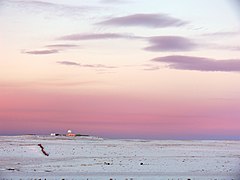| Quviasukvik ᖁᕕᐊᓲᑎᖃᕐᕕᒃ | |
|---|---|
 Some Inuit, Yupik, Aleut, Chukchi and Iñupiat believed that the sunrise on December 24a marked the beginning of the new year | |
| Also called | Quviasugvik, Inuit New Year, Happy Day,[1] Time of Joy[2] |
| Observed by | Inuit, Yupik, Aleut, Chukchi, Iñupiat, NunatuKavut |
| Type | Cultural (Inuit) Religious (Inuit religion, Shamanist and Christian) |
| Significance | Start of the year and the roaming of the spirits for good luck |
| Celebrations | Watching the first sunrise of the Inuit new year (December 24 onlya), parades (December 25 only), mass attendance, concerts, carnivals, fairs, Inuit traditional activities, family gathering, family meal, visiting friends and relatives, gift giving, gift shopping, goodwill greetings, late night partying, reflection, watching fireworks (December 31 only), qulliq ceremonies during the first sunrise of the Christian new year (January 1 only), Nalujuk Night (January 6), ringing of the first school bell after winter break (January 3 in Greenland; January 4, 5 or 6 only in Canada and Alaska; January 7 in Russia), flag raising ceremonies (January 7 only) |
| Date | December 24 to January 7 |
| Frequency | Annual |
| Related to | Christmas, Chinese New Year, Japanese New Year, Tibetan New Year, Korean New Year, Vietnamese New Year, Mongolian New Year, Sámi New Year, Yakut New Year |
Quviasukvik (Inuktitut: ᖁᕕᐊᓲᑎᖃᕐᕕᒃ; "Christmas"), is the first day of the year according to Inuit. The festival of the New Year is celebrated by Inuit, Yupik, Aleuts, Chukchi, NunatuKavummiut and the Iñupiat.[3] The feast originally derives from traditional Inuit religion but in modern times, it has Christian influences.[4][5]
- ^ Nunavut (Our Land) Episode 13: Quviasukvik (Happy Day)
- ^ Laugrand, Frédéric; Oosten, Jarich (2002). "Quviasukvik. The celebration of an Inuit winter feast in the central Arctic". Journal de la Société des Américanistes. 88 (88): 203–225. doi:10.4000/jsa.2772.
- ^ Quviasukvik: The Inuit Winter Festival & Christmas
- ^ Quviasukvik. The celebration of an Inuit winter feast in the central Arctic
- ^ Inuit Shamanism and Christianity